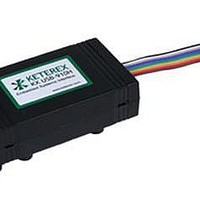KXUSB-910H Keterex, KXUSB-910H Datasheet - Page 8

KXUSB-910H
Manufacturer Part Number
KXUSB-910H
Description
Interface Modules & Development Tools USB-to-SPI/I2C Embedded Sys Intrfce
Manufacturer
Keterex
Datasheet
1.KXUSB-910H.pdf
(11 pages)
Specifications of KXUSB-910H
Interface Type
USB, I2C, SPI
Operating Supply Voltage
1.65 V to 5 V
Product
Interface Modules
Lead Free Status / RoHS Status
Lead free / RoHS Compliant
Available stocks
Company
Part Number
Manufacturer
Quantity
Price
Company:
Part Number:
KXUSB-910H
Manufacturer:
Keterex
Quantity:
135
Most simple data operations can be performed using a Quick Read or Quick Write. Both operations
move a block of data to or from a slave device using the normal I2C/SMBus read or write protocol (i.e. a
single START + Address + R/W bit + DATA + STOP).
However, the real power of the USB-910H Adapter is found in its ability to execute scripts supporting any
combination of bus transactions, delays, and I/O operations. A script is a string of data and simple
commands, each representing a low-level action to be performed, much like the list above (e.g. START +
Address + R/W …). The I2C/SMBus master device can execute the following actions:
Using this simple script capability, complex protocols can be layered onto the I2C/SMBus bus, including
handshaking using available general-purpose I/O.
10-bit addresses, or can respond to all 7-bit or all 10-bit addresses. The slave device supports both read
and write operations. For reads, the user sends the desired outgoing data to the Adapter prior to “arming”
it as a slave. If a bus master attempts to read more data than provided by the user, the slave continues
to transmit an internally-calculated PEC byte until a STOP is received. While addressed, the USB-910H
stores all incoming data, including the address bytes, in its internal buffers. This allows the host PC to
retrieve both the addresses and write data after the bus operation completes.
6.3.1. I2C/SMBus Master Operations
I2C/SMBus Master operations can be performed using three methods:
6.3.2. I2C/SMBus Slave Operations
As an I2C/SMBus Slave device, the USB-910H Adapter can either respond to up to 16 specific 7-bit or
8
•
•
•
•
•
•
•
•
1. Quick Write – Perform a bus write to a specific slave device using 7-bit or 10-bit addressing.
2. Quick Read – Perform a bus read from a specific slave device using 7-bit or 10-bit
3. Execute a Script – Execute a script to perform any combination of configuration, reads,
•
•
•
•
•
•
•
•
•
•
•
SCL low timeout and recovery.
SCL high bus-free detection.
Repeated STARTs.
Group commands (master and slave).
Bus fault detection.
Built-in 2.2kΩ pull-up resistors to a programmable V
Respond to up to 16 specific addresses or respond to all addresses.
Generate arbitrary bus faults for use in system testing.
addressing.
writes, delays, and general-purpose I/O operations.
Generate a START on the bus.
Generate a STOP on the bus.
Transmit a byte on the bus.
Read a specified number of bytes from the bus.
Delay a specified number of microseconds.
Write an automatically-generated PEC byte to the bus.
Read a PEC byte from the bus and compare to an automatically-generated value.
Read a byte from the bus and compare to a specified value.
Reconfigure the I2C Master settings (e.g. whether to retry if arbitration is lost, etc.).
Drive a specified pin low, high, or to High-Z.
Wait until a specified pin is high or low (with configurable timeout).
IO
(with enables).















